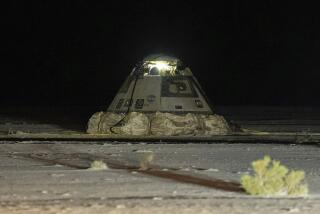For 2nd Time This Week, Shuttle Launch Is Delayed
- Share via
MIAMI — A large thunderstorm prevented Air Force Col. Eileen Collins and her astronaut crew of four from blasting off on space shuttle Columbia early today.
It was the second launch delay this week.
Launch director Ralph Roe made the call. “Due to the storm that is moving to the south, we need to scrub for the day.”
“Eileen, we gave it our best shot, but the storm didn’t agree with us,” Roe radioed Collins. “We best give it another try another day.”
“The crew will be ready to go at the next opportunity,” Collins assured him.
Lightning flashed around the launch site and thunder rumbled as NASA held the countdown at the five-minute mark in hopes the storm would pass by quickly. The launch director even added 10 minutes to the launch window, but it did not help.
NASA said it would try again early Friday.
The launch attempt Tuesday ended just seconds before liftoff when a dangerous hydrogen buildup was detected in the engine compartment. It turned out to be a false alarm.
Collins, 42, is the first woman to command an American spaceflight.
Among those who returned to the Kennedy Space Center in hopes of celebrating Collins’ historic flight were First Lady Hillary Rodham Clinton, a delegation of female members of Congress and the captain of the world champion U.S. women’s soccer team. Mrs. Clinton, daughter Chelsea and the entire team were on hand for Tuesday’s countdown.
Aboard the Columbia when it roars out over the Atlantic Ocean will be the largest, heaviest payload ever hoisted aloft by a shuttle. The $2.8-billion Chandra X-Ray Observatory weighs 25 tons and is stowed in the aft end of the Columbia’s cargo bay.
Although the shuttle’s three main engines have plenty of thrust to lift the Columbia and its cargo into an initial orbit 153 miles above Earth, NASA officials concede that the payload could complicate any emergency landing that might be necessary soon after liftoff. It is essential that the weather conditions be perfect for a launch, officials said.
Chandra, built by TRW Inc. of Redondo Beach, carries the world’s most powerful X-ray telescope and, once in its own elliptical orbit, will give scientists clues to understanding such cosmic mysteries as supernova, quasars and black holes.
The observatory will fly more than a third of the way to the moon and, through its 45-foot-long telescope, provide X-ray visions into the dark matter of the universe with a resolving power comparable to being able to read a stop sign from 12 miles away.
“Chandra will give us the opportunity to see some of the pieces that we haven’t been able to see before,” said astronaut Steven A. Hawley, 47, an astronomer making his fifth shuttle flight. “Hopefully, the grand design will become a little more apparent.”
In addition to Collins and Hawley, the Columbia crew includes another woman, Air Force Lt. Col. Catherine Coleman, 38, who went into space aboard Columbia in 1995; Navy Capt. Jeff Ashby, 45, making his first spaceflight; and French astronaut Michel Tognini, 49, who flew on the Russian space station Mir in 1992.
The telescope is named for the late Subrahmanyan Chandrasekhar, a Nobel-winning astrophysicist who taught at the University of Chicago. His 88-year-old widow, Lalitha, was on hand for the launch attempt.
More to Read
Sign up for Essential California
The most important California stories and recommendations in your inbox every morning.
You may occasionally receive promotional content from the Los Angeles Times.










